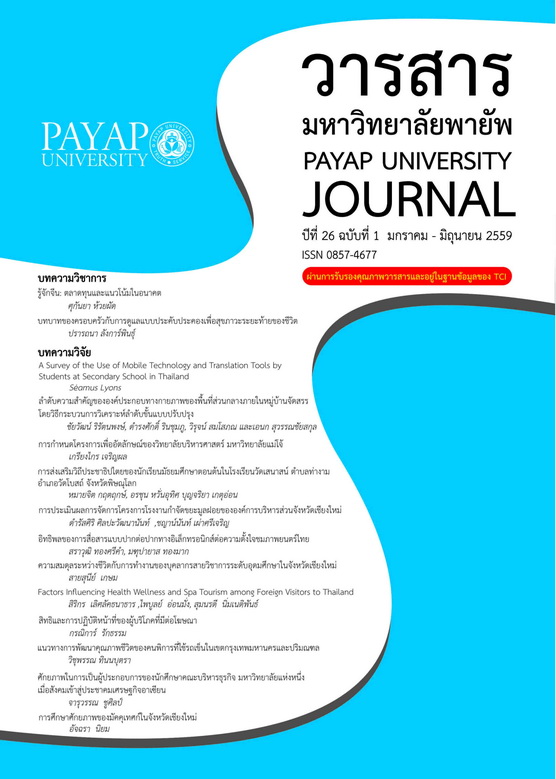FACTORS INFLUENCING HEALTH WELLNESS AND SPA TOURISM AMONG FOREIGN VISITORS TO THAILAND
Main Article Content
บทคัดย่อ
การศึกษานี้มีวัตถุประสงค์เพื่อศึกษาปัจจัยที่มีอิทธิพลต่อการท่องเที่ยวเชิงส่งเสริมสุขภาพสำหรับชาวต่างชาติที่มาท่องเที่ยวในประเทศไทยกับข้อมูลเชิงประจักษ์ ซึ่งเป็นการศึกษาวิจัยจากกลุ่มตัวอย่างนักท่องเที่ยวชาวต่างที่เดินทางเข้ามาท่องเที่ยวในประเทศไทย เครื่องมือที่ใช้ในการเก็บรวบรวมข้อมูลเป็นแบบสอบถาม จำนวน 400 ชุด วิเคราะห์ข้อมูลโดยใช้สถิติพรรณนา ได้แก่ ร้อยละ ค่าความถี่ ค่าเฉลี่ยเลขคณิต ส่วนเบี่ยงเบนมาตรฐาน สถิติทดสอบสมมุติฐานประกอบด้วยสถิติวิเคราะห์เส้นทางอิทธิพลและสถิติวิเคราะห์โมเดลสมการเชิงโครงสร้าง (SEM) จากผลการทดสอบองค์ประกอบยืนยันแบบจำลองโครงสร้าง พบว่า จากการวิเคราะห์องค์ประกอบเชิงยืนยัน โมเดลการวิเคราะห์มีความสอดคล้องกับข้อมูลเชิงประจักษ์ ซึ่งประกอบด้วย 9 ปัจจัยหลัก SIGX, SPAX, SPEX, SERX, SPIX, SPOX, SPRX, STEX and SUSX และ 25 ปัจจัยย่อยที่มีความเหมาะสมมีความเชื่อมั่น ความตรงเชิงโครงสร้างและเนื้อหาต่อปัจจัยที่มีอิทธิพลต่อการท่องเที่ยวเชิงส่งเสริมสุขภาพ
Article Details
เอกสารอ้างอิง
Cwalina, W. (2000). The use of structural equation model ling in social sciences, Poland. Stat Soft; Retrieved on January 1, 2014
Gotata, E. (1992). The possibilities of using path analysis in demograph. Demographic Studies, Vol. 4, No. 110, 13-29.
Goeldner,R., & Ritchie, J. (2009).Tourism: principle, practice, philosophies. Hoboken, NJ: John Wiley & Sons
Field, A. (2005). Discovering statistics using SPSS (2nd ed.). Thousand Oaks, CA: Sage Publication.
Hair, J. F., Black, W. C., Babin, B. J., & Anderson, R. E. (2010). Multivariate data analysis (7th ed.). Upper Saddle River, New Jersey: Prentice - Hall.
Lindeman, R. H., Merenda, P. F., & Gold, R. Z. (1980). Introduction to bivariate and multivariate analysis. Glenview, III: Scott, Foresman.
Hall,C.M.(1992) .Adventure Sport and Health Tourism in his Special Interest Tourism. London: Belhaven Press. 141-158. Retrieved on January 5, 2014
Rovinelli, R. J., & Hambleton, R. K. (1977). On the use of content specialists in the Assessment of criterion referenced test item validity. Dutch Journal of Educational Research, 2, 49-60.
Sagan, A. (2003). Measurement model of satisfaction and loyalty. (pp. 75-85), Polska: StatSoft http://www.statsoft.pl/czytelnia/marketing/pomiarowy. Retrieved on January 2, 2014
Smith,M., & Kelly,C. (2006). Holistic tourism : Journeys of the self?. Tourism Recreation Research, 31(1),15-24. Retrieved on January 3, 2014
Szwarc, K. (2006). Attempt to use path analysis to researching on poverty gap. In Jajuga K., & Walesiak M. (eds.), Taxonomy 12 Classification and Data Analysis - Theory and Application, Prace Naukowe Akademii Ekonomicznej we Wrocławiu, nr 1076, Wrocławiu: Wydawnictwo Akademii Ekonomicznej we Wrocławiu, 311-318.
Yamane, T. (1967). Statistics: An introductory analysis. (2nd ed). New York: Harper and Row.


